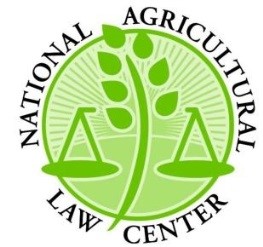A comprehensive summary of today’s judicial, legislative, and regulatory developments in agriculture and food. Email important additions HERE.
ANNOUNCEMENT: Join us tomorrow, October 4th, at 12 noon (ET) for an Agricultural & Food Law Consortium webinar: “Legal Issues with Data (Big and Small).” Details available here.
JUDICIAL: Includes tax and crop insurance issues.
In CHARLES D. MARTIN AND LAURA J. MARTIN, Petitioners v. COMMISSIONER OF INTERNAL REVENUE, Respondent, No. 15810-13, 149 T.C. No. 12 (Tax September 27, 2017), plaintiff owned a farm and rented a portion of their land to a corporation. They also built structures on the land to house the corporation’s chickens. Corporation paid plaintiffs for labor and rent. Revenue Commissioner claimed the rent was subject to self-employment tax. Court observed that, “[t]he facts of the instant case are not materially distinguishable from the facts of McNamara v. Commissioner, T.C. Memo. 1999-333, rev’d, 236 F.3d 410 (8th Cir. 2000).” Court found that plaintiffs established that the rent received “was at or below fair market value,” and commissioner “failed to show a sufficient nexus between the rental income and petitioners’ obligations to participate in the production or management of the production of agricultural commodities.” Court concluded the rent plaintiffs received pursuant to the lease “was not includible in their net self-employment income.”
In ISLAND FORK CONSTRUCTION, Petitioner, v. Jimmy BOWLING; Director, Office of Workers’ Compensation Programs, Respondents, No. 16-4319, 2017 WL 4324979 (6th Cir. September 29, 2017), a coal miner was eligible for benefits under the Black Lung Benefits Act. Issue was who should pay the benefits to the disabled miner “given that the responsible mine operator and the company that insured that operator are both insolvent.” Benefits Review Board found the Kentucky Insurance Guaranty Association (KIGA) was responsible for providing benefits. On appeal, KIGA argued that the Guaranty Act provides an exception for insurance “guaranteed by … governmental agencies.” Appellate court found the exclusions in the Guaranty Act do not apply because the Black Lung Benefits Act coverage in this case is not “ocean marine insurance” or “guaranteed by … governmental agencies.” Review Board decision affirmed.
REGULATORY: Includes USDA, APHIS, EPA, FWS, FDA, ISB, and NOAA rules and notices.
AGRICULTURE DEPARTMENT: Notice USDA submitted information collection requirement(s) to OMB for review. Title: Regulations and Statement of General Policy Issued under the Packers and Stockyards Act, and Related Reporting and Recordkeeping Requirements—Packers and Stockyards Programs. Details here.
ANIMAL AND PLANT HEALTH INSPECTION SERVICE: Rule amending the regulations concerning the importation of fruits and vegetables to allow the importation of fresh persimmons from New Zealand into the United States. Info here.
ENVIRONMENTAL PROTECTION AGENCY:
Rule EPA is taking direct final action to approve the 2011 base year inventory for the Baltimore, Maryland moderate nonattainment area for the 2008 8-hour ozone national ambient air quality standard. Details here.
Rule EPA is taking final action to approve a revision to the South Carolina State Implementation Plan (SIP), submitted by the South Carolina Department of Health and Environmental Control, on December 7, 2016, addressing the Clean Air Act (CAA) interstate transport infrastructure SIP requirements for the 2010 1-hour Nitrogen Dioxide (NO2) National Ambient Air Quality Standard. Info here.
Rule EPA is finalizing a significant new use rule under section 5(a)(2) of the Toxic Substances Control Act (TSCA) for the chemical substance identified generically as bimodal mixture consisting of multi-walled carbon nanotubes and other classes of carbon nanotubes, which was the subject of premanufacture notice (PMN) P-11-482. Details here.
FISH AND WILDLIFE SERVICE: Rule provides the regulatory alternatives for the 2018-19 duck hunting seasons, announces the Service Migratory Bird Regulations Committee (SRC) and Flyway Council meetings, and provides Flyway Council recommendations resulting from their March meetings. Info here.
FOOD AND DRUG ADMINISTRATION:
Notice FDA is announcing that a proposed collection of information has been submitted to the Office of Management and Budget (OMB) for review. Title: Establishing and Maintaining Lists of U.S. Milk Product Manufacturers/Processors with Interest in Exporting. Details here.
Notice FDA is requesting nominations for members to serve on the Tobacco Products Scientific Advisory Committee, Office of Science, Center for Tobacco Products. Details here.
INDUSTRY AND SECURITY BUREAU: Rule updates the Code of Federal Regulations (CFR) legal authority paragraphs in the Export Administration Regulations (EAR) to cite the most recent Presidential notice continuing a national emergency declared pursuant to the International Emergency Economic Powers Act. Info here.
NATIONAL OCEANIC AND ATMOSPHERIC ADMINISTRATION:
Rule NMFS is transferring 156.4 metric tons (mt) of Atlantic bluefin tuna (BFT) quota from the Reserve category to the General category for the remainder of the 2017 fishing year, to account for overharvests of the January, June through August, and September subquotas. Details here.
Rule decreases the possession and trip limits for Georges Bank cod for Northeast multispecies common pool vessels for the remainder of the 2017 fishing year, through April 30, 2018. Details here.
Rule that would authorize formation of a recreational quota entity (RQE) that could participate in the Pacific Halibut and Sablefish Individual Fishing Quota Program in International Pacific Halibut Commission Regulatory Areas 2C and 3A in the Gulf of Alaska. Info here.
Notice requesting extension of a currently approved information collection. Regulations at 50 CFR 665.16 require that all U.S. vessels with Federal permits fishing for Western Pacific fishery management unit species display identification markings on the vessel and gear, as specified in 50 CFR 665 and 50 CFR 300. Info here.
Notice requesting extension of a current information collection. The Cooperative Game Fish Tagging Program was initiated in 1971 as part of a comprehensive research program resulting from passage of Public Law 86-359, Study of Migratory Game Fish, and other legislative acts under which the National Marine Fisheries Service (NMFS) operates. Details here.
